

 |
 |
click on thumbnail to enlarge
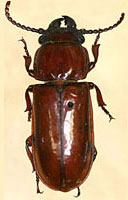
Neandra marginicollis (Schaeffer)
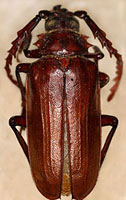
Prionus californicus Motschulsky

Graphisurus sp.
Drawing modified from Peterson 1951

Leptura sp.
Drawing modified from Peterson 1951
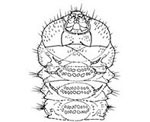
Leptura sp., ventral view
Drawing modified from Peterson 1951

Oberea tripunctata (Swederus).
Drawing modified from Peterson 1951

Orthosoma brunneum (Forster)
Drawing modified from Peterson 1951

Saperda vestita Say, ventral view
Drawing modified from Peterson 1951
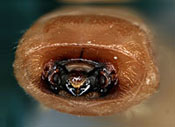
Arhopalus productus (LeConte), head
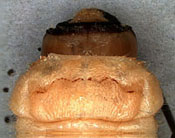
Monochamus sp., head in dorsal view
longhorn beetles, timber beetles, round-headed wood borers, cerambycid beetles
Global
~4000 genera and >35,000 species
Adult: Overall, body elongate and varying from sub-cylindrical to flattened, length ranging from 2-200mm (typically 5-50mm). Habitus vestiture variable from glabrous to clothed with moderate pubescence or scales; often surface with color patterns or metallic hues present. Head large and oriented in slightly to strongly deflexed position. Antennae 11-segmented in most, some with 10 segments and other variable from 12-25 or more in total; all with antennae elongate often exceeding length of body and in some greater than 2-3X body length; always simple without apical modification into club, etc. Mandibles typically robust and large and simple at apex, few with dentition. Eyes large and prominent, usually with anterior emargination where antennal insertions reside. Pronotum highly variable, margined and often denticulate in Prioninae. Legs typically elongate and well-developed, tarsi 5-5-5 but appearing 4-4-4 in most with 4th tarsomere minute and often inserted into bilobed 3rd tarsomere. Elytra variable from entire to brachypterous, most wood boring taxa with entire elytra that covers pygidium. Abdomen with 5-6 visible sternites.
Larva: Overall, body elongate, subcylindrical to slightly flattened, straight, lightly sclerotized surface, length ranging from 5-220mm. Sides of body often with lateral swellings or ampullae, typically parallel-sided or with prothorax enlarged. Overall vestiture typically simple scattered setae, sometimes with dense setae. Head typically retracted into prothorax. Mouthparts well-sclerotized in most wood boring taxa; mandibular mola absent, ventral mouthparts protracted, simple fixed mala, well-developed maxillary articulating area. Stemmata poorly developed or absent. Prothorax sometimes with areas of distinct asperities. Legs moderately to poorly developed or absent. Abdominal segments 1-6 or 1-7 typically with dorsal and ventral ampullae, rarely asperities may be present. Urogomphi reduced or absent. Anal opening usually Y-shaped or sometimes transverse. Spiracles always annular.
This family contains some of the most serious wood boring pest taxa
in the world. Many genera have been indicated as problematic in different
situations from structural wood products, agricultural products, to
forest ecosystems, including: Analeptes, Anoplophora, Arhopalus, Asemum, Asias, Dectes, Enaphalodes, Hylotrupes, Monochamus, Oberea, Phoracantha, Prionus, Xylotrechus, and many
others. Of these, the major concern in North America is for members
of the genus Anoplophora, which include the Asian Longhorn
Beetle Anoplophora glabripennis Motschulsky. This beetle is
native to Japan, Korea and southern China and attacks and kills healthy
trees including horsechestnut, many maple species, as well as other
hardwoods such as elm, poplar, willow, citrus and birch. So far, its
range in North America is restricted to the vicinity of New York City
and Chicago, where it was unintentionally introduced in wooden crate
material (solid wood packing material [SWPM]) originating from China.
Key player modified February 2018
Content last modified: February 4, 2011